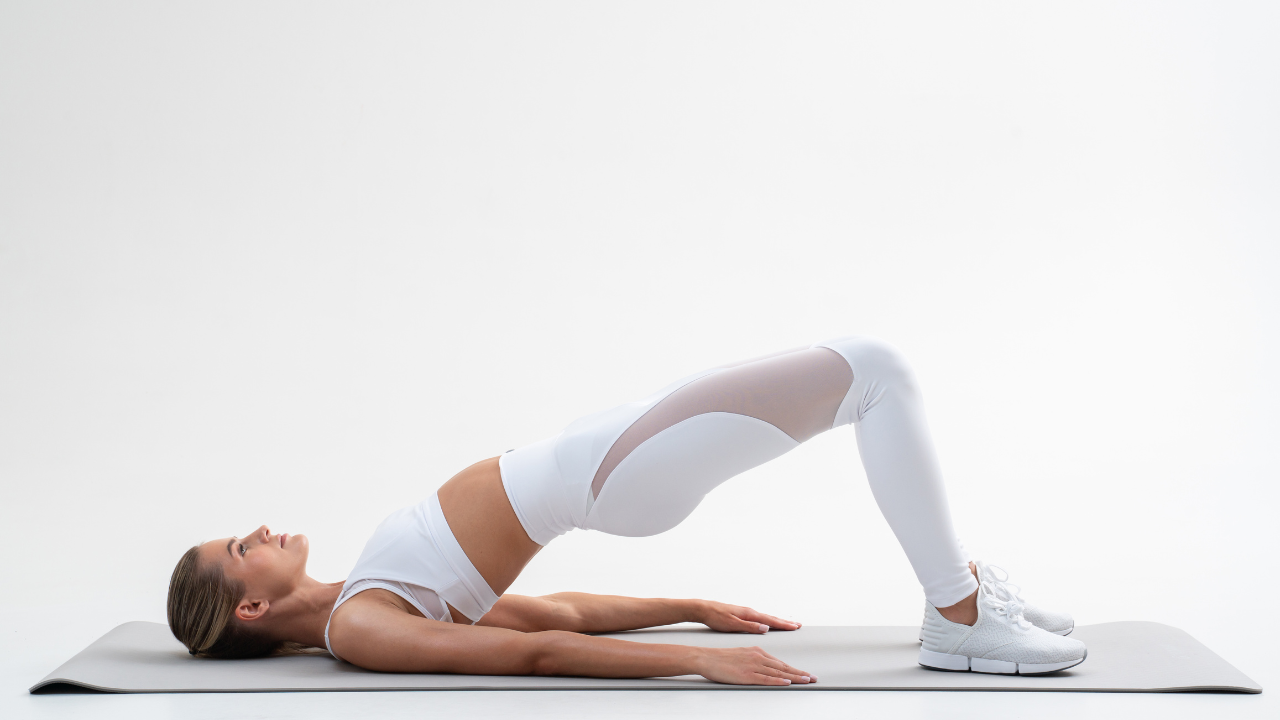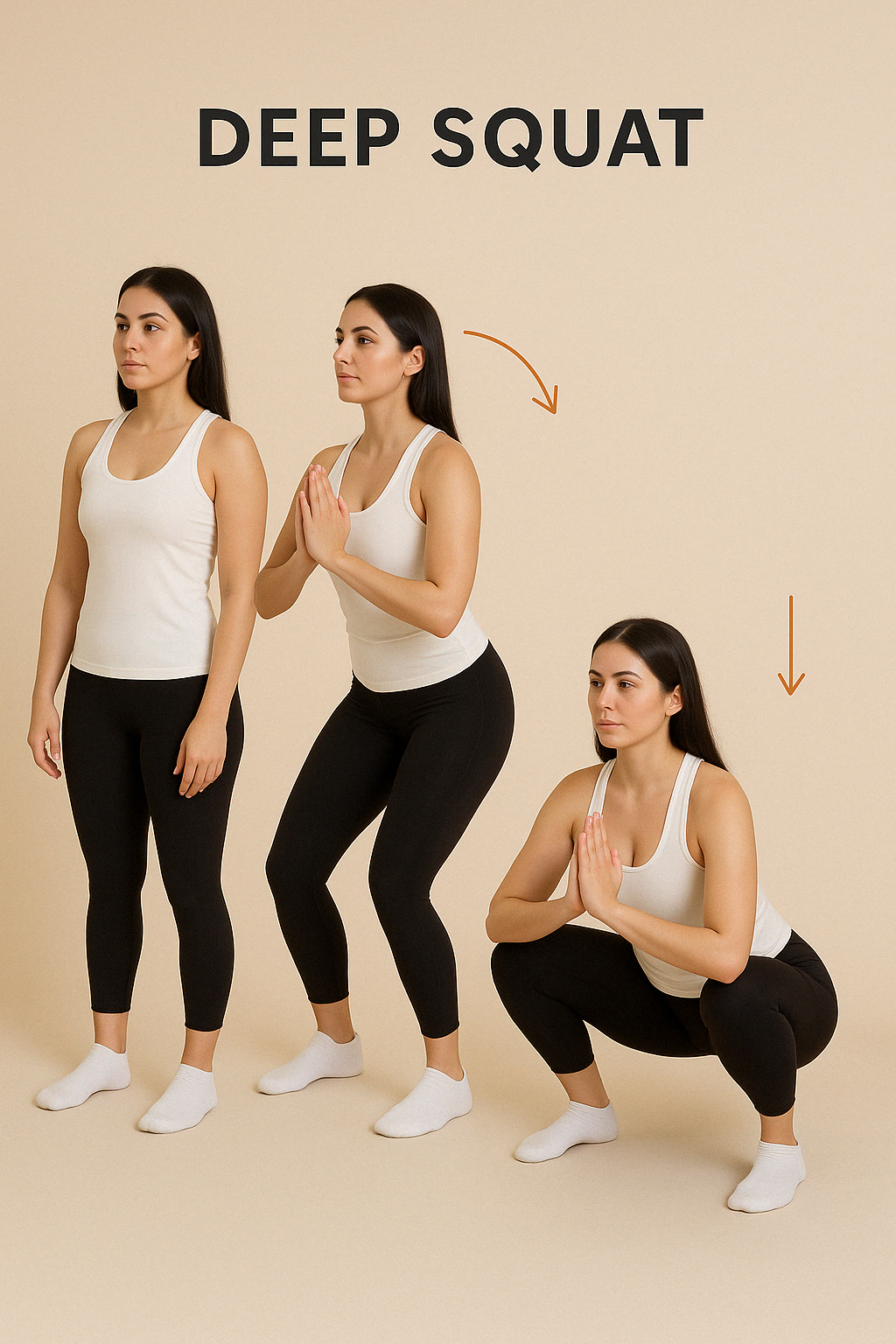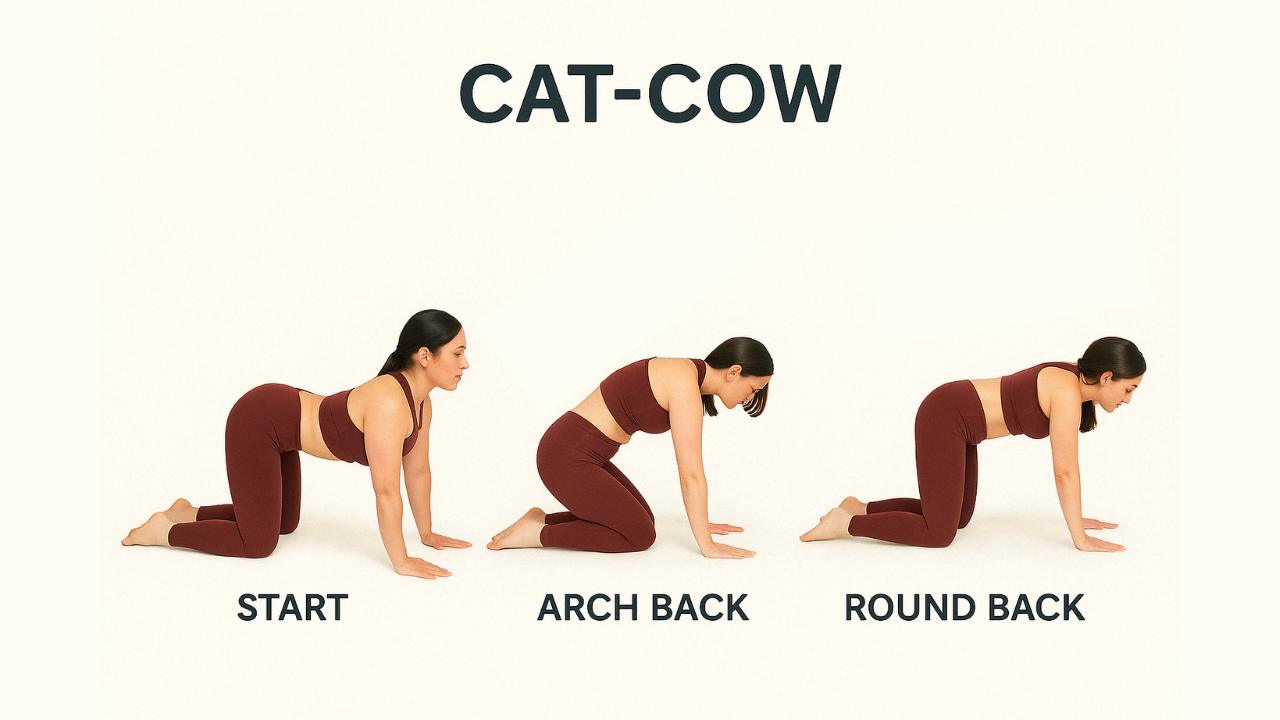
Table of Contents ▾
Your pelvic floor sits at the base of your pelvis and supports your bladder, bowel, and uterus. These muscles control how well you hold, release, stabilize, and feel. But when they’re too tight or too weak, they stop working the way they should. That’s when you start noticing leaks, hip stiffness, pressure in your lower belly, or discomfort during sex.
This guide will show you exactly how to stretch those muscles in a way that’s practical, doable, and designed for real life, so that you can operate at your best in the moments that matter most.
Benefits of Pelvic Floor Stretches
1. Stretching will help relieve your pelvic pains and tensions.
If you’re feeling a constant ache in your lower belly, a sharp sting near your vaginal opening, or soreness in your tailbone it is often caused by muscle tension. This pelvic pain is often caused by sitting all day, holding your breath or even just powering through stress. Together they add up to create pressure reducing circulation, which can lead to nerve pain.
2. Stretching helps reduce symptoms of pelvic floor dysfunction (PFD) and urinary incontinence.
If you’re leaking when you sneeze or feel like you can’t hold your bladder, the issue might not be the symptom of urinary incontinence or worse, it could be a simple tension issue. When your pelvic floor is always gripping and creating tension, it can’t relax fully to let you pee, and it can’t contract properly throwing off coordination between your bladder and core.
3. Stretching improves mobility and flexibility of the lower body.
If your hips feel stiff, your lower back aches after walking, or your stride has started to feel shorter than it used to, it might be more than just tight muscles.
When your pelvic floor is holding tension, it pulls on everything around it. That includes your hips, sacrum, and the muscles that control how your pelvis rotates. Over time, that tightness limits your mobility without you even realizing it, until your back starts overcompensating and movement feels harder than it should.
Stretches that target the pelvic floor and surrounding areas, like the glutes, inner thighs, and lower back, help restore natural movement. As those muscles start to release, your joints can move more freely, your stride opens up, and your whole lower body begins to move with less resistance and more control.
4. Stretching will support better sexual function and comfort
If sex has ever felt sharp, overly tight, or even like a burning sensation it may not mean you are imagining it or that there is something wrong with you.
That discomfort is often a sign that your pelvic floor is holding too much tension. When those muscles stay clenched, they restrict blood flow, compress nerves, and limit how much the vaginal tissue can expand. That makes arousal harder to access, and any kind of penetration feel more intense than it should.
Stretches that target your pelvic floor and surrounding muscles, like your inner thighs, hips, and glutes, help increase circulation and soften the tissue. As those areas release, blood flow improves, nerve sensitivity returns, and the body becomes more responsive to depth, pressure, and movement.
5. Stretching aids in managing overactive pelvic floor muscles.
If you’re feeling a heavy sensation in your pelvis, pressure that won’t go away, or the urge to pee even when your bladder isn't full, it’s not just in your head. And it’s not always about weakness.
These are common signs that your pelvic floor muscles are stuck in contraction. They’re staying switched “on” when they should be resting.
This often happens after years of clenching without realizing it, while sitting, working, breathing shallow, or pushing through stress. And when those muscles never get the chance to fully let go, they will eventually stop working the way they’re supposed to.
12 Pelvic Floor Stretches You Can Do at Home
Deep Squat

Deep squat helps release tightness around the vaginal opening and improves range of motion through the pelvis. If you’ve been sitting for long hours, clenching through stress, or feeling tight in your lower belly and hips, this stretch is a powerful way to release it.
Stand with your feet slightly wider than your hips and your toes turned slightly outward. Bend your knees and lower into a squat. Let your hips drop down and back. Press your elbows into your knees with palms together at your chest, or rest your hands on a stable surface for support.
If your heels lift off the ground, place a rolled towel or yoga block under them. Keep your spine tall and let your breath move all the way into your pelvis. Hold for 20–30 seconds. Repeat up to 3 times with rest in between.
Child’s Pose
This pose gently opens the hips, lengthens the lower back, and creates space through the pelvic floor. It’s also a powerful way to reset after sex, giving your nervous system and pelvic floor the chance to fully relax.
If your back feels tight or your hips feel heavy, this is the stretch to come home to. Child’s Pose helps you drop into your breath, soften through your pelvis, and release tension you didn’t even realize you were holding.
Kneel on the floor with your big toes touching and your knees spread wide. Gently fold forward, letting your belly rest on your thighs and your forehead lower to the floor or a pillow. Your arms can reach out in front of you or rest alongside your body.
If your hips feel tight or lifted, place a pillow under them for support. Focus on breathing deep into your belly, and let your exhale soften everything below it. Hold for 1–2 minutes. Take your time coming out, using your hands to press up slowly.
Hamstring Stretch
If your lower back feels tight, your hips feel stiff, or your posture always seems just a little off, your hamstrings might be pulling more than you think. When these muscles are tight, they tug on the pelvis and can create tension that affects the entire lower body, including the pelvic floor.
Sit on the floor with one leg extended and the other bent in. Inhale to lengthen your spine, then exhale as you slowly fold forward over your extended leg. Let your hands rest on your shin, ankle, or foot, wherever you land naturally. Bend your knee slightly or use a strap around your foot if reaching forward feels like too much.
Hold for 30–60 seconds on each side. Repeat up to 3 times if it feels good. By lengthening the back of the legs, you give your hips and lower spine more freedom to move, improving posture and reducing unnecessary strain on your pelvic floor. This stretch reduces restriction and supports a more responsive, open pelvic area, especially when you need your body to stay fluid and relaxed.
Bridge

Bridge activates the muscles that support your pelvis and spine. It strengthens the pelvic floor in coordination with the glutes and lower abdominals. If your core feels weak or your hips feel unstable, this movement gently activates your glutes, pelvic floor, and lower core, key muscles that stabilize your entire lower body. It also supports endurance in positions that require lower body engagement, so your body can move with less effort and more confidence.
Lie on your back with your knees bent and feet hip-width apart. Press into your feet and, as you exhale, slowly lift your hips. Hold at the top for a few seconds, then lower with control. Keep the movement small and steady. Focus on using your glutes and breath, not your lower back, to guide the lift. Think of lifting from your pelvis, not pushing from your spine.
Hold each lift for 5 seconds. Repeat 10–15 times. Rest as needed between rounds.
Diaphragmatic Breathing
If your body feels like it’s always on, tense jaw, shallow breathing, clenched core, Diaphragmatic breathing is one of the simplest, most powerful ways to calm your nervous system and release deep pelvic tension. This practice helps release unconscious gripping in your core and pelvic floor. It reconnects the natural rhythm between breath and muscle, so your body knows when to hold, and when to let go.
Sit comfortably or lie flat on your back. Place one hand on your belly and the other on your chest. Inhale through your nose, letting your belly gently rise under your hand. Exhale slowly and fully, feeling your belly soften and fall.
Keep your breath slow and low. If it helps, place a book or warm compress on your belly for added feedback. Practice for 5 minutes a day, or any time you feel tension creeping in. You can use this before sleep, after stress, or as a way to reset between tasks.
Happy Baby
If your hips feel tight or your pelvis holds a kind of pressure you can’t quite explain, this stretch is a great way to let it all soften. Happy Baby is a gentle opener for the hips, inner thighs, and deep pelvic floor muscles, especially helpful if you’re carrying tension without realizing it. This stretch opens the hips, groin, and pelvic floor. It helps decompress the base of your spine and encourages deep release in the muscles that often stay clenched from sitting, stress, or overdoing it.
Lie on your back and bend your knees, lifting your feet up toward the ceiling. Reach for the outsides of your feet (or your ankles if that’s more accessible), and gently draw your knees toward your armpits. Keep your tailbone heavy on the floor. If your lower back lifts off the ground, place a blanket under your hips for support. Let your breath move into your belly, and feel your pelvis soften on every exhale.
Hold for 30 seconds to 1 minute. If it feels good, gently rock side to side.
Pelvic Tilt
If your lower back feels stiff, your pelvis feels locked up, or your core feels disconnected, Pelvic tilts reintroduce movement to the base of your spine and reconnect the subtle coordination between your core and pelvic floor. Pelvic tilts wake up the deep muscles at the base of your core. They improve mobility in the spine, ease lower back stiffness, and bring awareness to your sacral area, making your whole pelvic system work together more smoothly.
Lie on your back with your knees bent and feet flat on the floor. As you inhale, gently tilt your pelvis forward so your lower back arches slightly. As you exhale, tilt your pelvis back, pressing your lower back into the floor. Move slowly and with control, like you’re drawing a small circle with your tailbone.
Keep the movement small, subtle is enough. Focus on the sensation coming from deep inside your pelvis, not your abs or hips. Let your breath guide the pace, especially your exhale. Repeat 10–15 times. Take your time. Rest in between rounds if your lower back feels sensitive.
Cat-Cow

If you tend to hold tension in your lower back, hips, or tailbone, this is the stretch you come back to. It helps you soften where you've been holding and build rhythm between your spine, pelvis, and breath.
This stretch loosens the lower spine, tailbone, and hips. It also brings movement back into your pelvic floor, guiding it through a natural rhythm of expansion and contraction as you breathe. That rhythmic movement is what keeps your pelvic floor responsive, not reactive.
Come onto your hands and knees with your wrists under your shoulders and knees under your hips. Inhale as you gently arch your back and lift your tailbone toward the ceiling (this is your “cow” position).
Exhale as you round your spine and tuck your pelvis under (your “cat” position). Let your breath guide the pace. Repeat the movement 10 times, breathing slowly and fully. Pause longer in the positions that feel especially tight.
Lunge
Sitting for hours, carrying stress, even wearing restrictive clothing, all of it shortens the front of your hips and adds pressure to your pelvic floor. This stretch targets your hip flexors and psoas, deep, stabilizing muscles that often pull your pelvis into tension without you realizing it. Releasing them helps realign your hips and takes pressure off your pelvic floor so your whole lower body moves more freely.
Step one foot forward and lower your back knee to the floor. Shift your hips forward gently until you feel a stretch through the front of your back leg. Keep your chest lifted, your shoulders relaxed, and your breath steady. Keep your front knee stacked directly over your ankle, and focus on keeping your hips square to the front. Hold for 30 seconds on each side. Repeat twice if it feels good to your body.
Kapotasana (Pigeon Pose)
If your hips feel locked up or you carry a lot of deep tension in your glutes, Pigeon Pose is one of the most effective ways to release tightness in the outer hips and glute muscles, especially the ones that quietly pull on your pelvic floor and limit how your pelvis moves.
This pose targets the glutes, piriformis, and deep hip rotators. When those muscles are tight, they put pressure on the pelvic floor and disrupt how your pelvis aligns and responds. Releasing them helps restore balance and takes tension off the base of your core.
Start on your hands and knees. Bring one knee forward and place it behind your wrist. Extend the opposite leg straight back behind you. Keep your hips as square as possible, and gently fold forward over your front leg. If your hips feel uneven or you can’t lower fully, slide a pillow or block under your front hip. Hold for 1 minute on each side. Let your breath do the work.
Kegel Exercise
If you’ve ever dealt with leaks, weak orgasms, or just a sense of disconnection from your core, Kegels help you strengthen the pelvic floor muscles so they can support your body and respond when you need them to.
Kegels help retrain your pelvic floor to contract and release on command. That means better bladder control, stronger core support, and a more responsive pelvic base overall.
Sit or lie down in a comfortable position. Gently squeeze and lift those pelvic floor muscles, without tightening your abs, glutes, or inner thighs. Then fully release. If you want more feedback and deeper awareness, try using inserting a Yoni Egg. It helps you feel the movement more clearly and adds gentle resistance. Hold each contraction for 5 seconds, then relax completely. Repeat 10–15 times, or until you feel gently fatigued.
Knee to Chest Stretch
If your lower back feels tight or your hips feel heavy after sitting for too long, this stretch is a gentle way to release that tension. It helps ease the kind of deep pressure that builds up in the glutes, sacrum, and pelvic area, especially after long days or high-stress moments.
This stretch gently lengthens the lower back, opens up the glutes, and reduces the pulling tension that can affect your pelvic floor. It’s especially helpful after long periods of sitting or anytime your body feels emotionally or physically heavy.
Lie on your back with both knees bent and your feet flat on the floor. Draw one knee in toward your chest and hold it with both hands. Let the other leg stay extended or bent, whichever feels better for your body. Keep your head and shoulders relaxed on the ground. As you pull your knee in, breathe into your belly and let your pelvic floor soften with each exhale. No forcing, just gentle release. Hold for 20–30 seconds per side. Repeat up to 3 times if it feels good.
Supine Pelvic Floor Stretch
This stretch one of the gentlest ways to teach your pelvic floor how to rest, especially if you’ve been stuck in clenching or high-alert mode for a while. This stretch gently opens the hips, groin, and pelvic floor, without engaging any muscles. It gives your body a chance to unwind long-held tension and reintroduces the feeling of softness and safety in your pelvic bowl.
Lie on your back with your knees bent and feet flat on the floor. Let your knees slowly fall open to the sides, bringing the soles of your feet together. Rest your arms by your sides with your palms facing up.
If your inner thighs feel strained, place pillows or blocks under your knees for support. Focus on slow belly breaths, and with every exhale, imagine softening through the base of your pelvis. Hold for 1–2 minutes. Let gravity and breath do the work.
Conclusion: Take Charge of Your Pelvic Health
Your pelvic floor is part of how you move, how you feel, and how you access comfort, strength, and pleasure in everyday life. These muscles work quietly, but their impact shows up everywhere, from the way you stand, to how your hips feel after a long day, to the way your body responds during intimacy.
Each stretch in this guide is a way to listen to your body more clearly. To respond instead of push, yo create softness where there's been holding, and movement where things have felt stuck.
When you start paying attention to your pelvic floor, things begin to shift, and with consistency, your body becomes more coordinated, more comfortable, and more available for the moments that matter.
